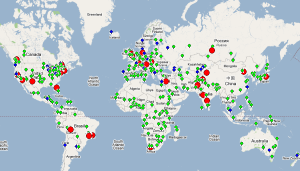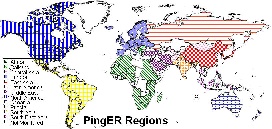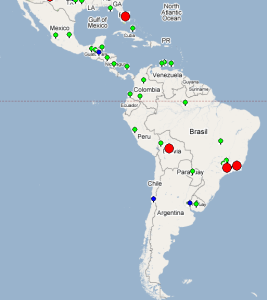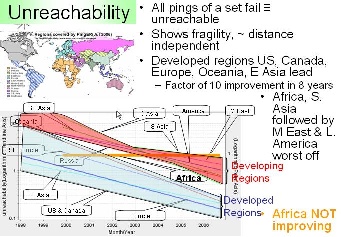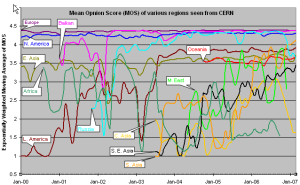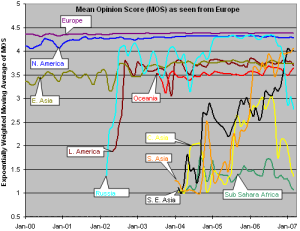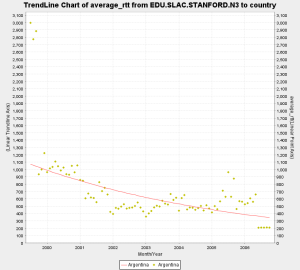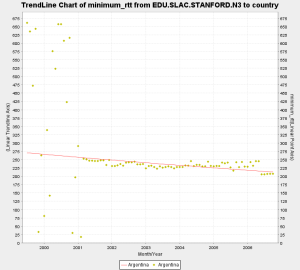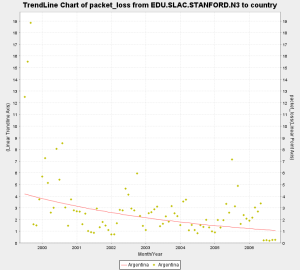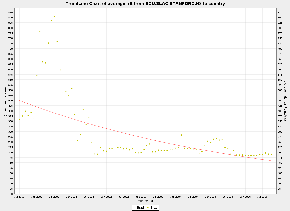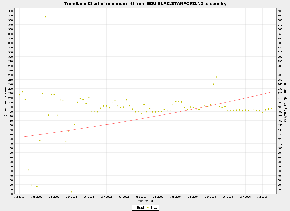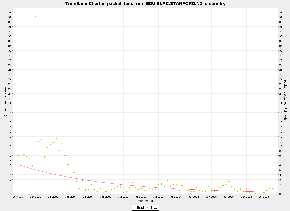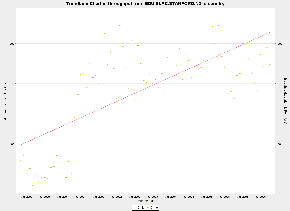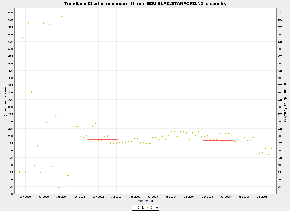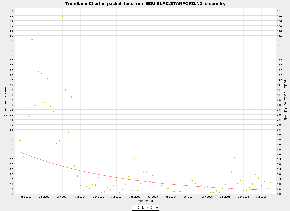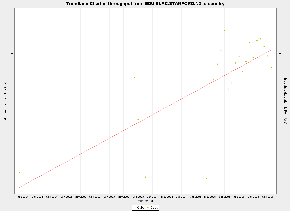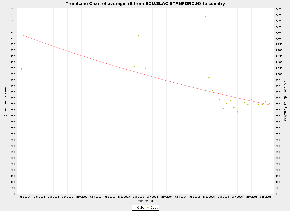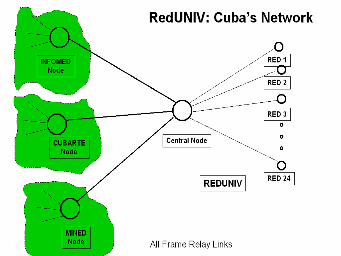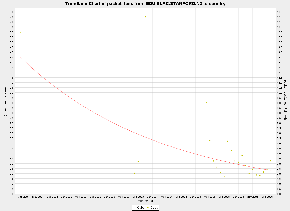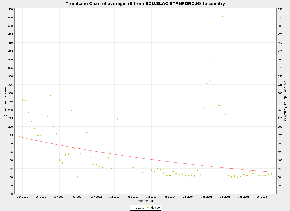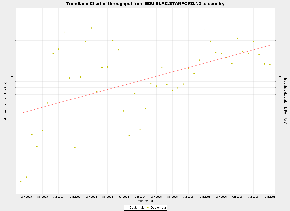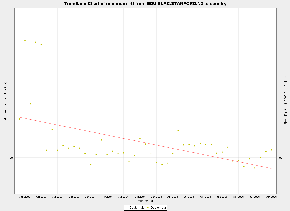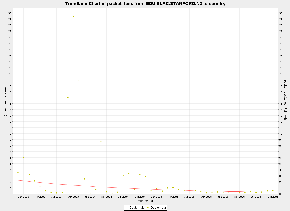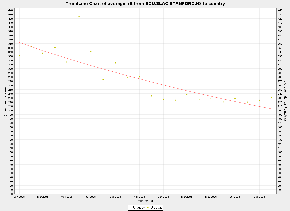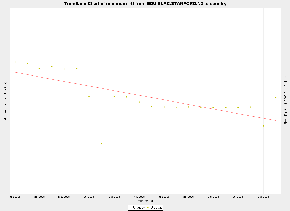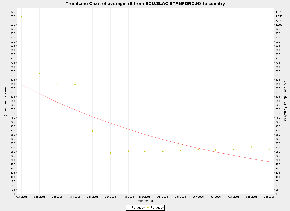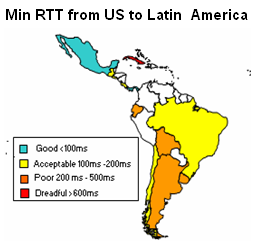PingER Coverage
The sites from which there is PingER monitoring are shown in red below, sites which are monitored by all monitoring hosts (these are referred to as beacon sites and also include monitor sites) are shown in blue, and other monitored remote sites are shown in green. From SLAC PingER monitors about 460 sites, CERN used to monitor about 132 sites, however after re-installing in December 2006) they now only monitor beacon sites (56). ICTP Trieste monitors 105 sites but only has data going back to September 2006. To the right of the PingER map we also show a map which defines how we are assigning countries to regions.
Latin America includes South America, Caribbean and Mexico. We have three monitoring hosts in Brazil (two in Sao Polo and one in Rio De Janeiro) and one monitoring host in Bolivia.The map below shows the location of the sites.
Latin America Compared to the rest of the World
Before we start to compare L. America to the rest of the world it is useful to look at a World Map of Internet Users. This shows that for most the developed world (US and Canada, W. Europe, Japan, Taiwan, S. Korea) typically 40% or more of the people have Internet connectivity while for S. Asia it is less than 15%, i.e. typically a factor of 3 less.
From SLAC: 1. Packet Loss, 2. Min RTT to World Regions, 3. Unreachability, 4. Jitter
The left hand figure shows the packet loss to various regions of the world as seen from N. America. Since losses are fairly distance independent no attempt has been made to normalize the data. It is seen that the world divides up into two major super-regions: N. America, Europe, E. Asia and Oceania with losses below 0.1%, and Latin America, C. Asia, Russia, S.E. Asia, S. Asia and Africa with losses > 0.1% and as high as as a few per-cent. All countries are improving exponentially, but Africa is falling further behind most regions.
The left middle figure shows the drop in the Minimum RTT from 2002-2006. The large step for S. Asia in 2003 was due to the change over from satellite to fibre. as the result of gradual shift from Satellite to fiber. Central Asia (also Afghanistan) has hardly moved in its minimum RTT since it continues to use geostationary satellites.
The right middle graph shows the unreachability of world regions seen from the US. A host is deemed unreachable if all pings of a set fail to respond. It shows the fragility of the links and is mainly distance independent (the reasons for fragility are usually in the last mile, the end site or host). Again the developed regions US and Canada, E. Asia, and Oceania have the lowest unreachability (< 0.3%) whil the other regions have unreachability from 0.7% to 2%, and again Africa is not improving, with S. Asia having the second worst unreachability.
The right hand graph shows the jitter or variability of world regions seen from the US. The jitter is defined as the Inter Quartile Range (IQR) of the Inter Packet Delay Variability (IPDV i = RTT i - RTT i-1) . The Jitter is relatively distance independent, it measures congestion, and has little impact on the Web and email. It decides the length of VoIP codec buffers and impacts streaming. We see the usual division into dveloped verus developing regions.
MOS for various regions
There are three factors that significantly impact call quality: latency, packet loss, and jitter. We calculate the jitter using the Inter Packet Delay Variability (IPDV) , see the tutorial for further details.
Most tool-based solutions calculate what is called an "R" value and then apply a formula to convert that to an MOS score. Then the R to MOS calculation is relatively standard. The R value score is from 0 to 100, where a higher number is better. To convert latency, loss, and jitter to MOS we follow Nessoft's method. The graphs below shows the Exponentially Weighted Moving Average (using EWMI i = alpha * EWMI i-1 + (1 - alpha) * Obs i where alpha = 0.7 and EWMI 1 = Obs 1) for the MOS as seen from the W. Coast of America (SLAC) and Switzerland (CERN). N.B. MOS values of one are reported for heavy loss (loss > 40 %).
|
|
|
Mean Opinion Score as seen from the US |
Mean Opinion Score as seen from CERN |
Mean Opinion Score as seen from Europe |
|---|
CERN monitors fewer remote hosts than SLAC (56 versus over 400) so the data is not as complete in the CERN case. Comparing the two graphs, it can be seen that, as expected, the MOS is better for the shorter distances (i.e. CERN to Europe is better than SLAC to Europe, SLAC to N. America is better than CERN to N. America.).
It is also seen in both graphs that the Balkans, Russia and Latin America improved dramatically in 2000-2002. Much of Latin America and Russia moved from satellite to land lines in this period. It can be seen from the above plot that VoIP ought to be successful between SLAC and the US, Europe, E. Asia, Russia, Latin America and the Mid East (all above MOS = 3.5). S. E. Asia is marginal, S. Asia people will have to be very tolerant of one another, and C. Asia and Africa are pretty much out of the question in general. In general the CERN graphs looks similar to the SLAC graph to the various regions, except that S. E. Asia is worse for CERN than SLAC as is S. Asia
The third graph shows the Mean Opinion Score (MOS) from Europe two various regions. We have five monitoring sites in Europe (one at CERN, one at ICTP, one in Germany, and two at UK. The improvement in Latin America and Russia in 2002 is the result of shift from satellite to fiber. The drop for Russia in Sep, 2006 is because we installed a new version of PingER and it started monitoring 9 hosts in Russia whereas previously it was monitoring 20 hosts. For Central Asia the number of sites went up from 3 to 15 in Sep 2006, so the latter results are a better indication of the overall performance of Central Asia. For Sub Sahara Africa the coverage improved in Sep, 2006 (increased from 8 to 39 sites). So for sub Sahara Africa the results after Sep 2006 presents a better picture. South Asia as seen from Europe is performing better than as seen from US because MOS is derived from average RTT which is distance dependent.
Argentina
In December 2001, Argentina's (RETINA) connected to AMPATH, so the increase in performance to Argentina can be seen from SLAC. Around June 2006 the TCP throughput of Argentina increased significantly. The average RTT reduced from 600 ms to 200 ms. The minimum RTT reduced from 250 ms to 200 ms.The packet loss has also decreased significently.
Brazil
Around Janruary 2001 - July 2001 the loss decreased from 8 % to 1 %. The Average RTT decreased from 375 ms to 200 ms
The TCP throughput improved but it havent stabalized (still lots of variation)
Chile
In June 2001, Chile's REUNA becomes the first LA NREN(National Research and Educational Network) to get connected to the Ampath POP in Miami. As a result the TCP throughput increased significently. Minimun RTT reduced from 230 ms to 200 ms and Average RTT reduced from 725 ms to 250 ms Packet loss reduced from 10 % to 1 %.
Cuba
Poor performance due to satellite link.Average and min RTT are about 800ms. Packet loss is around 2-4 % in 2006
(The only hope for Cuba is to connect to RedClara) RedClara plans to connet to Cuba in the near future
Mexico
July 2003 performance improved . Minumum RTT became stable 100 ms to 60 ms and Average RTT also became stable.
but Janruary 2005 to July 2005 again problem arose
Gutemala
Janruary 2005 packet loss becomes stabalizing >1% April 2003 minimum and average RTT improved
Uruguay
Since Uruguay joined in June, 2005 its TCP throughput has improved. Average RTT reduced from about 325 ms to 225 ms
Minimum RTT reduced from about 270 ms to 220 ms The loss situation hasent seen much improvement
Paraguay
Shift from satellite to fibre at the start 2006.
Traceroute from SLAC to Latin American Countries
Routes from Brazil to other Latin American Countries
Brazil to Ecuador: Brazil -> Spain(Madrid) -> Ecuador OR Brazil -> US (Kansas) -> Ecuador
Brazil to Cuba: Brazil -> US(Miami) -> (Satellite Provider) -> Cuba
Brazil to Venezuela: Brazil -> Europe -> Venezuela OR Brazil -> US -> Venezuela OR Brazil -> Spain(Madrid)-> Venezuela
Brazil to Costa Rica: Brazil -> US -> Costa Rica
Brazil to Argentina: Brazil -> US -> Uruguay -> Argentina
Brazil to Mexico: Brazil -> US(California) -> Mexico
Brazil to Chile: Brazil -> US -> Uruguay -> Chile
Brazil to Uruguay: Brazil -> US (California) -> Uruguay
Brazil to Bolivia: Brazil -> US (Kansas) -> Italy (Rome) -> Bolivia
Brazil to Paraguay: Brazil -> Spain (Madrid) -> Paraguay
Brazil to Honduras: Brazil -> US(Kansas) -> Guatemala -> Honduras
Brazil to Peru: Brazil -> US(California) -> Uruguay -> Peru
Brazil to Colombia: Brazil -> US (Kansas) -> Colombia
Brazil to Guatemala: Brazil -> US -> Gutemala
Brazil to El Salvador: Brazil -> Spain (Madrid) -> El Salvador
Brazil to Panama: Brazil -> US -> Italy(Rome) -> Panama
ALICE and RedCLARA
Since its launch in September 2004, the ALICE project has been a key component in reducing disparities within Latin America by bridging the "Digital Divide" both within the region and with the rest of the world. The project has enabeled Latin American researchers to become key players in the global research community.
On September 1 of 2004, RedCLARA began to provide direct connectivity with 155 Mbps, in "a ring" topology, linking the NRENs of Argentina, Brazil, Chile, Panama and Mexico, and connecting them to GÉANT at 622 Mbps throughout a connection between São Paulo, Brazil, and Madrid, Spain.
Minimum RTT and Packet Loss from US to Latin American Countries
Figure shows the Min RTT and packet loss to Latin American countries from SLAC. Mexico seems to have the least RTT and acceptable loss due to its direct connectivity with the US. Argentina, Brazil and Chile are also performing reasonably well. Bolivia, Ecuador and Paraguay are catching up. However Cuba is still stuck to satellite and the performance is dreadful.
